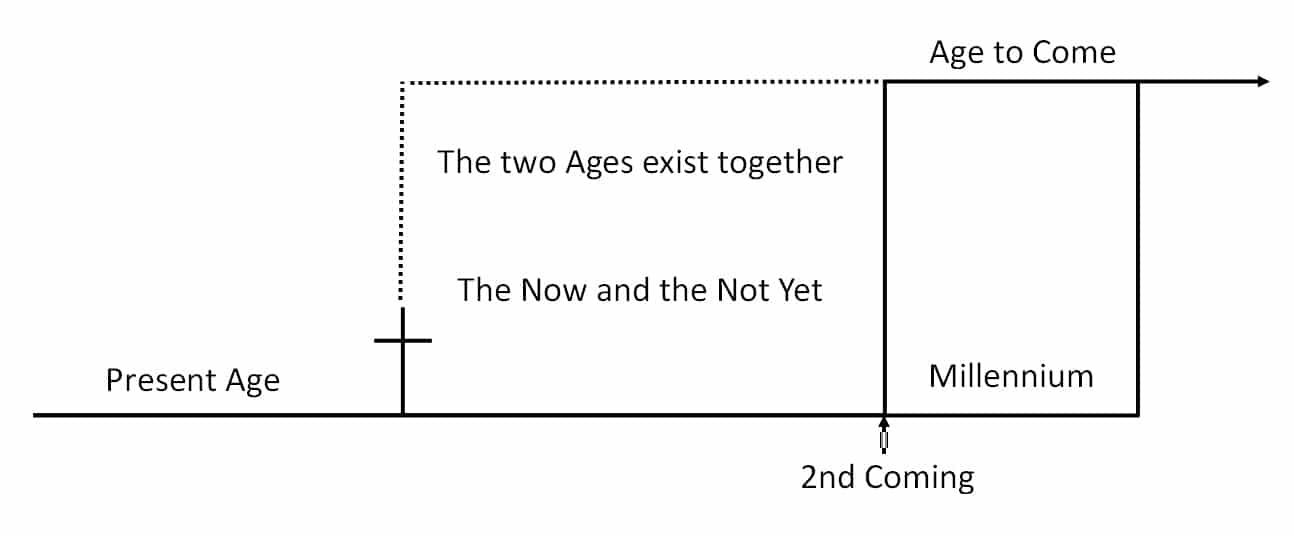Kingdoming Well Part 5
In our discussion on the Kingdom of God we have been diagraming the transition from this present Age to the Age to Come. We introduced 1 Corinthians 15:22-26 as being one of the key verses to understanding the Kingdom of God and how it ties together all of the concepts we have been discussing.
1 Corinthians 15:22-26 (NIV)
22 For as in Adam all die, so in Christ all will be made alive. 23 But each in his own turn: Christ, the firstfruits; then, when he comes, those who belong to him. 24 Then the end will come, when he hands over the kingdom to God the Father after he has destroyed all dominion, authority and power. 25 For he must reign until he has put all his enemies under his feet. 26 The last enemy to be destroyed is death.
We have been talking about the tension of living between the two Ages in what we have been calling the Now and the Not Yet. The Kingdom is here, but not fully here. The power of the Age to Come has broken through into this present evil Age at the cross. Jesus inaugurated the Kingdom when He came the first time, He will consummate it when He comes back again.
To further illustrate this concept we are going to take some time to look at another fascinating picture of living in this tension that is presented in the seven feasts that God commanded Israel to observe every year.
All seven feasts are recorded in Leviticus Chapter 23. The seven feasts are Passover, Unleavened Bread, First Fruits, Pentecost, Trumpets, Atonement, and Tabernacles.
That all seven feasts are recorded in Leviticus 23 is significant. If you were wanted to be faithful to the Lord in the Old Testament this would be the one chapter of scripture that you would need to memorize. Remember, if you missed the sixth feast, the Day of Atonement, you would be banished from the chosen people.
In Christ, we are no longer required to keep the feasts, but understanding them is of significant value in our seeing how God has moved so amazingly and consistently in the lives of His people. As we look at the feasts we are going to see how Jesus has already fulfilled the first three, how the fourth one was fulfilled at Pentecost, and that we are waiting for Jesus to come back to fulfill five, six, and seven.
The first of the seven feasts is the Passover. Jesus would celebrate the Passover with His disciples on the last night of His earthly ministry.
Leviticus 23:5 (NIV)
5 The LORD’s Passover begins at twilight on the fourteenth day of the first month.
There is not a big description of the Passover in this chapter, just this one verse. The children of Israel had just celebrated the first Passover so it would still be fresh in their minds. All of the amazing events of that first Passover are recorded in Exodus.
This one verse is critical in that it gives the starting date each year for all seven feasts. Passover would begin at twilight on the fourteenth day of the first month. God uses a lunar calendar to mark time. Each month starts with a new moon which reaches a full moon in the midst of a twenty-eight day cycle. The lunar calendar is much better than a solar calendar. The sun does not change daily, we either see it whole or we don’t see it. As long as the night time sky is clear, the moon looks different every night. If you were practiced in the lunar cycle, you could make a very accurate estimate of what day of the month it was.
We read in Exodus 12 about the events of that first Passover:
Exodus 12:5-7 (NIV)
5 The animals you choose must be year-old males without defect, and you may take them from the sheep or the goats. 6 Take care of them until the fourteenth day of the month, when all the people of the community of Israel must slaughter them at twilight. 7 Then they are to take some of the blood and put it on the sides and tops of the doorframes of the houses where they eat the lambs.
In the New Testament, we read that Jesus is the lamb and that His blood will be pored out for the forgiveness of sin.
John 1:29 (NIV)
29 The next day John saw Jesus coming toward him and said, “Look, the Lamb of God, who takes away the sin of the world!
Matthew 26:27-28 (NIV)
27 Then he took the cup, gave thanks and offered it to them, saying, “Drink from it, all of you. 28 This is my blood of the covenant, which is poured out for many for the forgiveness of sins.
Just as the Jewish people marked their house with the blood of the lamb so that the Angel of Death would Passover them, we mark our house, our body, with His blood and we too are spared from the Angel of Death. Our eternal lives start when we accept Jesus as savior. Jesus perfectly fulfills the Passover requirements of being a lamb with spot or defect, and He offers Himself of the exact day of the feast.
The next feast is Unleavened Bread. It begins on the next night.
Leviticus 23:6 (NIV)
6 On the fifteenth day of that month the LORD’s Feast of Unleavened Bread begins; for seven days you must eat bread made without yeast.
In the new Testament we see that Jesus is our unleavened bread.
John 6:35 (NIV)
35 Then Jesus declared, “I am the bread of life. He who comes to me will never go hungry, and he who believes in me will never be thirsty.
John 12:24 (NIV)
24 I tell you the truth, unless a kernel of wheat falls to the ground and dies, it remains only a single seed. But if it dies, it produces many seeds.
Leaven in the Bible almost always symbolized sin. Paul talks about the feasts of Passover and Unleavened Bread in 1 Corinthians:
1 Corinthians 5:6-8 (NIV)
6 Your boasting is not good. Don’t you know that a little yeast works through the whole batch of dough? 7 Get rid of the old yeast that you may be a new batch without yeast–as you really are. For Christ, our Passover lamb, has been sacrificed. 8 Therefore let us keep the Festival, not with the old yeast, the yeast of malice and wickedness, but with bread without yeast, the bread of sincerity and truth.
Jesus was buried at the beginning of the feast of Unleavened Bread. His body was put in the tomb at sundown of Passover, which was also the beginning of the fifteenth day.
The kernel of wheat we read about in John 12 was placed in the ground and He would rise again at the appropriate time. Everything was happening according to the schedule of the feasts. For example, crucifixion normally took several days of agony to result in death. It was cruel and horrible and it was why the Romans chose to use it. Jesus died in a matter of hours, because that was what the schedule of the feasts required. Jesus was placed on the cross at 9:00am and taken down from the cross at 3:00pm so that there would be time to be buried by sundown. Remember, Jesus said that no one could take His life from Him.
John 10:17-18 (NIV)
17 The reason my Father loves me is that I lay down my life–only to take it up again. 18 No one takes it from me, but I lay it down of my own accord. I have authority to lay it down and authority to take it up again. This command I received from my Father.”
The next and third feast is First Fruits. First fruits was to be observed on the day after the Sabbath, which would be Sunday. Since the feast of unleavened bread was seven days long, one of those days would be a Sunday and that Sunday would be the First Fruits of that year. First Fruits was to be a celebration of the fertile land that God had given His people. It would be celebrated with a wave offering of the early crops of the spring harvest.
Leviticus 23:10-11 (NIV)
10 “Speak to the Israelites and say to them: ‘When you enter the land I am going to give you and you reap its harvest, bring to the priest a sheaf of the first grain you harvest. 11 He is to wave the sheaf before the LORD so it will be accepted on your behalf; the priest is to wave it on the day after the Sabbath.
Just as Jesus did with Passover and Unleavened Bread, He fulfills this feast also.
1 Corinthians 15:22-24 (NIV)
22 For as in Adam all die, so in Christ all will be made alive. 23 But each in his own turn: Christ, the firstfruits; then, when he comes, those who belong to him. 24 Then the end will come, when he hands over the kingdom to God the Father after he has destroyed all dominion, authority and power.
He even presents the First fruits offering to God!
Matthew 27:51-53 (NIV)
51 At that moment the curtain of the temple was torn in two from top to bottom. The earth shook and the rocks split. 52 The tombs broke open and the bodies of many holy people who had died were raised to life. 53 They came out of the tombs, and after Jesus’ resurrection they went into the holy city and appeared to many people.
The next feast comes fifty days after First Fruits, Pentecost.


